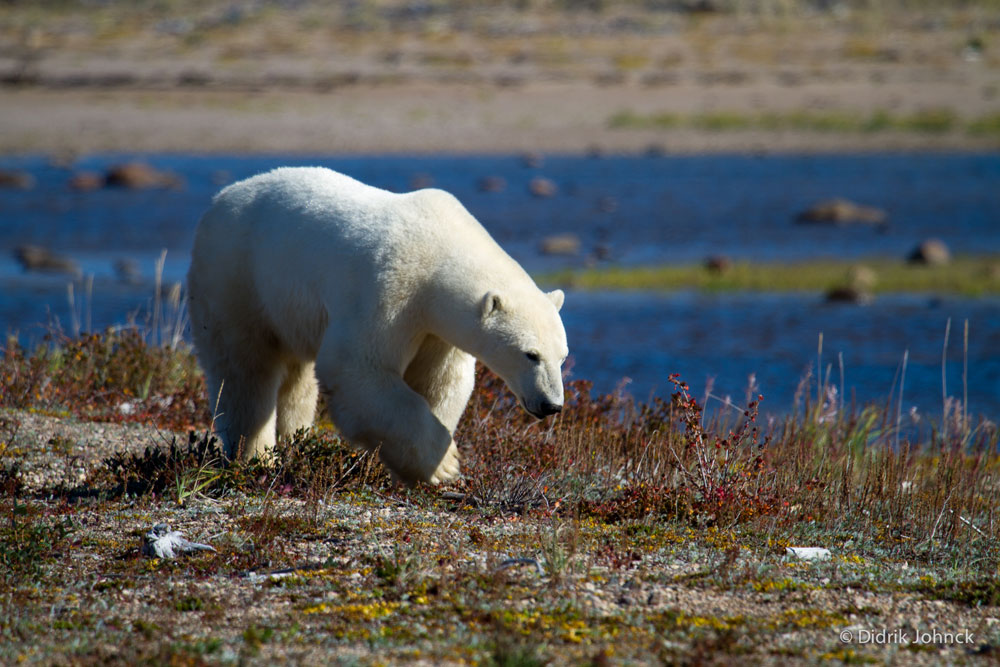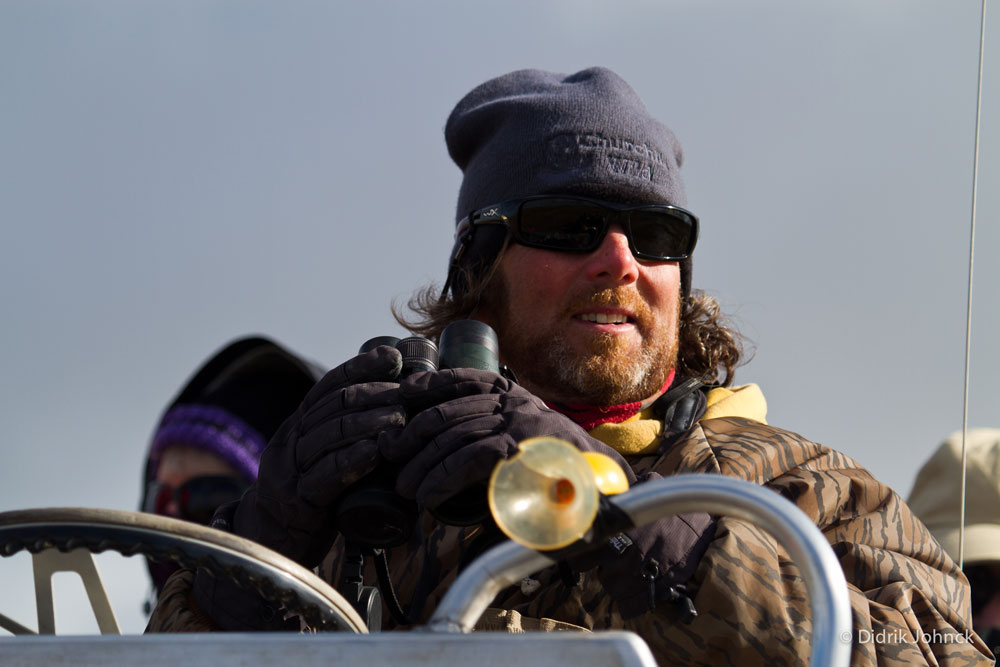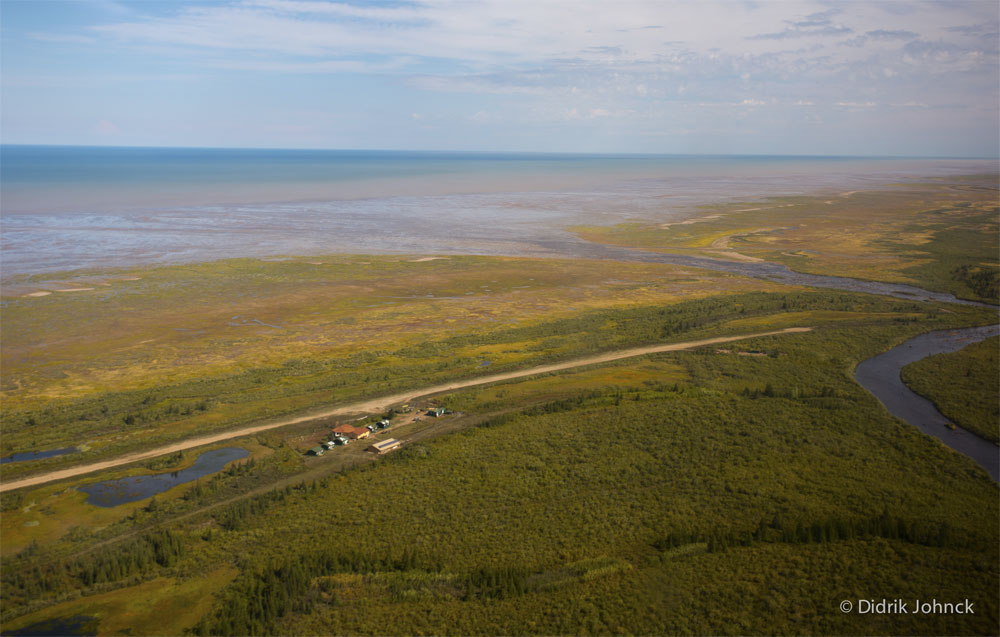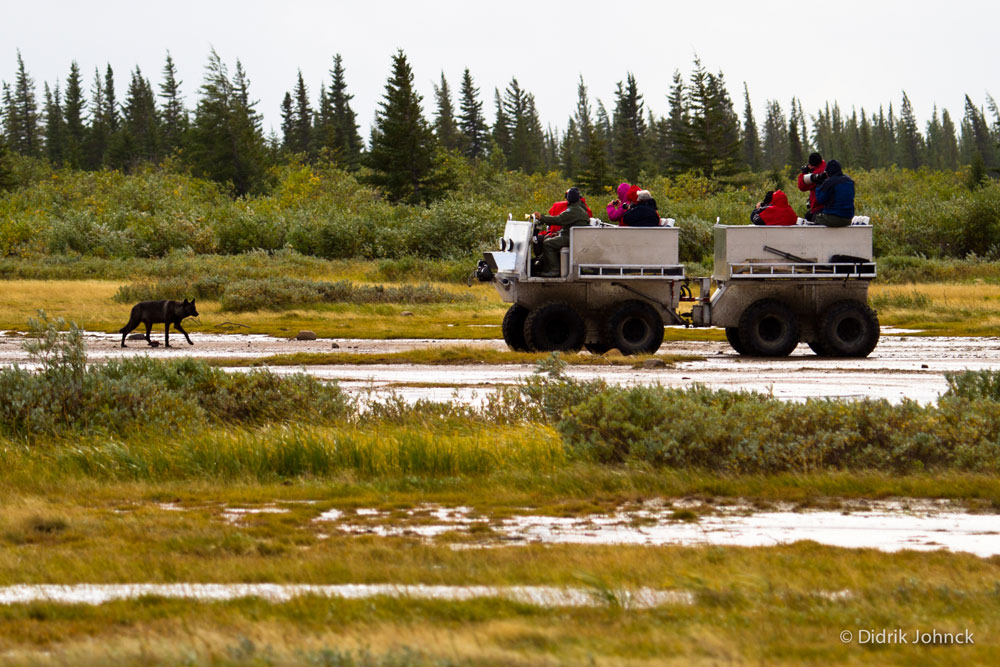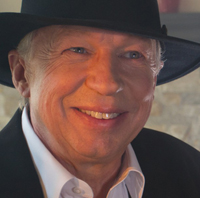This story originally appeared in Huffington Post Travel. It is republished here courtesy of author Richard Bangs. Photos courtesy of Didrik Johnck.
You can’t drive here; you can’t boat here; you can’t even walk here… you’d be eaten. We’re somewhere in the back end of nowhere, some 300 kilometers from the closest paved road; 1500 kilometers from the nearest Whole Foods. If you cry wolf here, everyone believes you.
It’s the third day of a week-long safari. Not in Tanzania, Botswana, Zambia or anywhere in Africa. We’re in the sub-Arctic, on Cape Tatnum, Hudson Bay, Manitoba, 57 degrees North Latitude. We’re on foot, in knee-high Wellies, sloshing single-file behind our guide, Andy MacPherson, towards a big mother polar bear. The general rule is to halt 50 or more meters from a polar bear. They’re master predators, largest land carnivores on the planet, top of the food chain, and are hungry this time of year. They feast on ice-breeding seals in the winter months, hunting from floating bergs on Hudson Bay, “The Cold Ocean.” But when the ice breaks in July, sleuths of bears come ashore and wait.
There are some berries and birds, and the occasional whale carcass that washes up onto the sand. But mostly the bears live off stored fat reserves and wait for the ice to come back in mid-November. It is the longest period of food deprivation of any mammal on earth. Now it’s September, when the sun describes a horseshoe around the margins of the sky, and life is beginning to drain from the land. The beasts are, at this time, justifiably famished.
Not many get to see polar bears in the wild. Most who do take a Tundra Buggy tour in Churchill, riding in giant tank-like buses that allow looking down at the melancholy wandering of Ursus maritimus without any chance of attack. Others see the bears from the decks of cruise ships plowing through the Arctic Oceans. But very few ever actually walk among the bears.
Some call Andy “The Polar Bear Whisperer.” He doesn’t disavow the title, but admits he can’t really Dolittle with the bears; rather he has come up with techniques to “keep them off balance.” Polar bears are intelligent, curious, and socially complex, he says, though there are several instinctive responses to humans approaching, and each bear has his own contextual personality and reaction. If she deems approaching vehicles, or a walking group, threatening, she might turn and run. Or she might charge. But once a response kicks-in, it is near impossible to stop. So, if kept disoriented, Andy postulates, she won’t decide on an action, but will wait for more information.
“Each time we interact with a bear we have the opportunity to add either positive or negative experiences to her toolbox,” he softly explains. “And that accumulation of knowledge affects the bear’s decision-making process.”
We have slowly walked around a long sandbar, being careful to stay downwind of “Pihoqahiaq,”(the ever-wandering one), as the Inuit call her. Her eyesight is supposedly similar to ours, but the ears are much better. And it’s very quiet here. The few sounds the polar bear knows include the crack of ice, the whoosh of wind, and the claver of geese. So, the human voice is unfamiliar, and can potentially trigger the wrong behavior.
So, Andy signals us to be quiet. The white giant, though, stands up, and begins to amble in our direction on large, silent feet. Her face is inscrutable, though the eyes say someone is home. She taps the air with her Roman nose, which has, Andy says, a better sense of smell than a bloodhound. I imagine everyone is thinking the same as me… if she attacks, who will be the slowest runner. The bear keeps stepping towards us. The Arctic air suddenly seems hot from the flame of risk. I expect Andy to back up, but instead he steps towards the bear…. a face off. Andy has two small rocks in his hand, which he clicks, a sound meant to keep the bear a little off-balance. And Andy speaks to her, a note of mysticism in his voice.
“Hi Beautiful. We’re just here to say hello. How is your day?” He speaks in a low monotone, which he says sounds like Charlie Brown’s teacher to the bear. It is meant to be non-threatening, and mildly confusing. The bear and Andy keep moving closer, and we obediently stay behind, and formally still.
I look around to scope an escape route, but there is nothing. We’re a kilometer from the taiga forest, which doesn’t have a tree worth climbing anyway. On the other side, the second largest bay in the world, named for doomed explorer Henry Hudson, with water deadly cold, and bears are faster swimmers anyway. Behind is a loamy coastline, desolate as the mare on the moon, and polar bears can outrun a race horse from a standing start. I recall a bit of advice I heard from a guide years ago on the Seal River: “Most polar bears are left-pawed, so if the beast charges, leap to her right.” But I used to be a guide, and know the adage true: “How do you tell if a guide is lying? His lips are moving.”
Regardless, all bets are on Andy. He continues to step forward, facing the bear, eye-to-eye. He clicks the rocks. Slung around his shoulder is a 12-gauge shotgun; on the belt of his camouflaged chaps, a starter pistol and a can of pepper spray. His back-up: Albert Saunders, a Swampy Cree born near here, bringing up the rear, and equally equipped. Albert has worked this coastline for years, laying trap lines in the winter, and hunting polar bears, with binoculars, in the summer.
Finally, less than 20 meters from one another, the bear turns, and plods away, like a bulldozer back to the yard. It would have taken her seconds to leap forward and rip off Andy’s head. But she chose something else. We all let out sighs. It was, all and all, a sublime encounter, an agreeable kind of horror.
The 18th century Irish philosopher, Edmund Burke, tried to account for the passions evoked in the human mind by what he called “terrible objects.” He was interested in our psychic response to things that seized, terrified, and yet also somehow pleased the mind by dint of being too big, too fast, too powerful, too uncontrollable to be properly comprehended. He wrote: “Whatever is fitted in any sort to excite the ideas of pain, and danger, that is to say, whatever is in any sort terrible, or is conversant about terrible objects, or operates in a manner analogous to terror, is a source of The Sublime; that is, it is productive of the strongest emotion which the mind is capable of feeling.” He went on to summarize that terror was a passion that “always produces delight, when it does not press too close.”
There are few places where one can plunge into the reality pudding of proximity to an ice-loving ursid, or any large predator, on the ground, in the field, eye level, with no fences or glass between. The Nanuk Lodge, named for “the master of the polar bears” in Inuit mythology, is one such place.
It takes at least two days to get to sub-Saharan Africa from almost anywhere in North America, and once there it takes a few days to get through the fog of jetlag. It takes me a day to reach the western edge of Hudson Bay from Los Angeles, two time zones away, arriving in time for moose burger soup, and an afternoon safari into the habitat of the Monarchs of the North.
I fly commercial to Winnipeg, capital of Manitoba, and then Calm Air to Gillam, a dam town on the Nelson River, and finally a charter Britten-Norman Islander over endless spots of water that look like human eyes glittering or brooding, as the mood strikes, mirroring, it might seem, the soul of the landscape. We bank sharply, and then swoop to land at the small dirt strip in front of Nanuk, corrugated with footprints the size of hubcaps.
Nanuk Polar Bear Lodge, owned by Churchill Wild, is surrounded by a 10′ high page wire fence, evoking the feeling that we, the humans, are in the zoo, especially when the animals rear haunches and place paws on the linkage. Inside the fence is a boneyard of animal skeletons found nearby, adding to the Planet of the Beasts sensation. Within the first few hours a black bear and a polar bear circle around our cage, looking for a way in. They bite, shove and pull at the wire mesh. We climb the wooden viewing tower, half as an added precaution. The polar bear finds a cardboard box, filled with empty wine bottles, awaiting an air pickup, and sticks her snout in for a few good sniffs. When she finally chooses to move on, we retire to the Common Room, and snack on caribou bacon wraps, and sip Pinot noir in front of the large handmade stone fireplace, backed by a huge bay window that looks, when a bald eagle perches on a black spruce outside, like a giant screen saver.
We’re utterly, completely, totally off the grid, except for the satellite Wi-Fi. The protracted twilight is spent reviewing digital photos of the day, thousands of them, posting on social media, and generally committing philosophy. The group is mostly Australian, and a few Canadians. My friend Didrik and I are the only Americans, or South Americans as some Canadians consider anyone from south of the 53rd parallel.
Dinners are Northern gourmet, freshest tundra-to-table to be found, as Riley the cook hunts much of the fare just beyond the fence. The exception being the quinoa chocolate cake, which I suspect took some ingredients not within walking distance.
The following days are rich with sensation and awe, and the simple admiration that wildlife can survive in an environment that would defeat us in very short order. After breakfast we board one of the two open-air lodge vehicles, a standard Honda quad bike, and a custom-built 8-wheel drive “aluminum rhino” (a Geo Metro engine inside, and moose antler for a stick shift… it looks, from the front, a cross between the #5 robot in the movie Short Circuit and WALL-E). Neither vehicle offers any protection from 1000 lb. feral quadrupeds, but that’s the point.
As our space station of a lodge fades into the distance we witness flights of avifauna fancy, from avalanches of snow geese, to peregrine falcons, to tundra swans, golden plovers, and the rubber ducky horn perched on the silver rhino. We carve an anfractuous path along a land so raw it looks as though the clock has been reset to zero, across silt flats, peat lands and sedge grasses, through vast, luminous country that provides the supremely satisfying sensation of existing in the midst of something absolute… even if it isn’t.
On the second day, under light that is soft, diffuse and intense at once, we trundle out through bogs and boreal forest towards the mudflats, and at the verge of a small river two black wolves, in full autumnal pelage, lope across our paths. We stop; they stop. The wolves are so fine-looking, but practically pulse with power and barely suppressed savagery. The tension between beauty and violence could snap a winch cable. They approach, and cautiously circle our vehicles. They snuffle, like dogs, and step within a few feet of us.
It’s such a naked, raw, unpredictable experience, knowing that a random, inexplicable tap could trigger a Siegfried and Roy tiger attack. Or what happened to Timothy Treadwell, The Grizzly Man. Or SeaWorld orca trainer Dawn Brancheau, as recounted in the film Blackfish. It would take a trice for the wolves to get to us, to drop us like caribou. But, after several minutes of consideration, they turn and lumber off like shadows into a thicket of birch and bush.
Each day we set out in our all-terrains, bobbing through the landscape like boats in a storm. We constantly scope the unsummarized shores of Hudson Bay, and with wildlife sightings, dismount the vehicles and watchfully walk as close as Andy deems safe. In this original scape we witness a range of polar bear behavior, up close and personal.
This is the season, and the prime place, for mothers and c.o.y.s., “cubs of the year,” and we gawp as a mother and her two cubs rest in a day-nest scooped from the sand beneath a turning willow, when another mom, with three cubs trailing, comes galloping across the badlands, either ready to pounce, or fleeing from some unseen hazard. Regardless, the first mom takes no chances, and hastens out of her nest, while the running bear and cubs take over the spot, and settle down. It’s a bear country jamboree.
Under streaks of bone-colored clouds, scratches in the sky, we watch patiently as a bear holds it head like a sphinx, taking her own council, never moving a wit. Another pair on the beach stands erect on hind legs, like taxidermies in The Explorers Club, and battles one another for some sort of dominance. I glass the scene with my Steiners and watch their white fur rippling like a field under wind. A
Another mother emerges from an inlet, shaking the water from her fur like a huge dog, sending out a bloom of spray that glitters in the air like grains of mica. She then swaggers up a small hummock, and turns our way, massive shoulders rolling, expressionless eyes boring into ours. When her big sloped head yawns we all try not focus on the size of her teeth. Every time she moves, Andy clicks his rocks, as though the two actions are connected by a string. It’s all very human-like, and comprehensible, even if we don’t really know anything of what she is doing or thinking. Then, she stops, lies down, and ignores us, so we head back the Lodge.
“Quork, quork, quork:” the sound at the door, the one with the moose antler handle. Andy enters cupping a wood frog in his palms. It is the cryogenic Walt Disney of Manitoba, in that it spends its winter, frozen solid, but then thaws out to full animation about the time polar bears are leaving the ice for land in the summer. Despite the violence outside our windows, inside Nanuk I am threatened only by a surfeit of tea, hospitality and a tiny green frog.
On the final night, after a dinner of fresh trout, we’re interrupted during a dessert of Pavlovas and cream with an uninvited guest, a polar bear at the fence rattling the postern. But as if the scene is not rich enough, the clear night sky begins to light up with the Aurora Borealis, looking like something at the edge of a dream. What a combo…a giant ice bear at our gate, and the Northern Lights above.
We gather outside, into air dank as an oyster, to bathe in the light of this optical phenomenon. I feel as though inside some great fishbowl, a captive on the inside, peering out to a larger universe. A thin nebulous cloud of green appears directly overhead and hovers, changing every few seconds. Suddenly, the fishbowl is alive as flickering tongues of jade lick the “glass” of the bowl, and dancing flames encircle us, spreading up toward some unknown height. Noiselessly they build to a pulsating green, then grow into an electric, dizzying fury. I wrap one hand around the porch rail in a death grip, and place the other over my brow as though to shade my eyes. Finally, I have to head to my room to avoid vertigo.
Gloomy is the day of departure, the surface of Hudson Bay like the lacquered black of Japanese wooden boxes. Looking back at the needles of light flashing over the water, I can’t help but admire this union of what is beautiful and terrifying, this place, which has, until recently, repelled the meddling of Man.
For so much of human history we’ve lived to dominate the natural world, believing the earth a machine that would never break. We are victims of the shears that cut man from nature and nature from man. We today have few elevated conversations with the land, little sense of interconnectedness.
Whatever one’s personal belief system, this landscape, and a safari through it, can provide vital perspective and bearings; can feed the springs of reverence and affection; can quicken our sense of wonder, provoke the imaginings of death, eternity and infinity, and inspire us to great deeds of preservation. More than almost any experience, a stay at Nanuk, validates our brief trek in time; and keeps the wolf of insignificance from our door.
About the Author:
Richard Bangs has often been called the father of modern adventure travel, having spent 40 years as an explorer and communicator, and pioneering “virtual expeditions” on the Web. He led the first descents of 35 rivers around the globe, including the Yangtze in China and the Zambezi in Southern Africa, while at the same time founding Sobek Expeditions, the first multi-national river running company and the pioneering outfitter for global active wilderness travel.
He has published more than 1000 magazine articles, 19 books, a score of documentaries, several CD-ROMs, and all manner of digital media, and has lectured at the Smithsonian, the National Geographic Society, the Explorers Club and many other notable venues. He writes a semi-regular feature for HuffingtonPost.com, occasionally freelances for other print and online publications, and produces and hosts “Richard Bangs’ Adventures with Purpose, as seen on national public television.
In the early 1990s Sobek merged with Mountain Travel to become Mountain Travel-Sobek (mtsobek.com), then as now, a leader in international adventure and eco-travel. Richard began TerraQuest, one of the first online travel projects, and went on to Microsoft as founder and editor-in-chief of Mungo Park, a pioneering interactive publishing effort. He was also part of the founding executive team of Expedia.com, and served as its Editor-at-Large. He was creator and publisher of Expedia Travels Magazine (published in partnership with Ziff-Davis), executive producer of Expedia Radio, and founder and executive director of Expedia Cafes.
Richard has also served as president of Outward Bound; created the “Well Traveled” series for Slate.com; was founding editor and executive producer of MSNBC’s “Great Escapes”; and produced “Richard Bangs Adventures” for Yahoo! He lives in Southern California with his family. You can also find Richard on Twitter and Facebook. For more detailed information, please visit RichardBangs.com.

